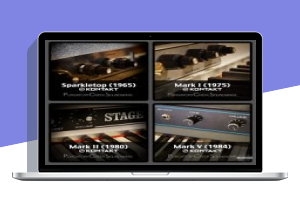
KONTAKT – 3,12 GB
蒂恩集合
《炼狱溪》的声音集《 Tine Collection》包括不少于四架基于音叉的机电钢琴,这些钢琴的制造时间近二十年。每个都体现了其产生时代的本质。
该集合包括以下所示的所有工具:
-马克一世(1975)
马克五世(1984)
马克二世(1980)
-Sparkletop(1965)
Kontakt仪器的布局相似。您会发现一个三频段均衡器,释放样本的音量和一个“速度曲线”对话框,该对话框使用户可以调整仪器以响应触摸。此外,每个都有立体声颤音,移相器和混响效果的控件。最后,提供了许多放大器模拟。
总体而言,您以合理的价格在单个集合中拥有四台深采样的基于音叉的机电钢琴。
马克一世(1975)
电动钢琴基于该样本集,于1975年生产,这一年被许多人认为是该乐器的黄金时代。它具有令人垂涎的托灵顿尖齿。
《炼狱克里克声ware》(Mark I,1975年)以记录的19个速度水平进行了深度采样,记录了整个持续时间,因此您既不会听到环路,也不会听到人工包络线的衰减。几乎对钢琴的每个音符都进行了采样,并包括了八个音速释放样本的速度层。该仪器使用69MB的RAM,需要930MB的可用磁盘空间。
马克五世(1984)
Mark V钢琴于1984年推出,是电钢琴制造商生产的著名的基于齿的钢琴的最新版本。它包括许多增强功能,从而形成了真正出色的乐器。
炼狱溪声音软件Mark V在整个持续时间内以20个速度水平采样,提供了准确的声音,没有人工衰减包络线或采样环。此外,还包括20个释放样品的速度层。该仪器使用59MB的RAM,需要914MB的可用磁盘空间。
马克二世(1980)
Mark II钢琴以其模块化的动作和Schaller尖齿而著称,与早期型号相比,声音有所不同。炼狱溪声ware Mark II(1980)很好地捕捉了原著的音调。
仪器以16个速度水平采样了整个持续时间,提供了准确的声音,没有人工衰减包络线或样品环。几乎对钢琴的每个音符都进行了采样,并包括了八个音速释放样本的速度层。该仪器使用46MB的RAM,需要760MB的可用磁盘空间。
Sparkletop(1965)
这是1960年代制造的,是著名的基于齿的钢琴制造商的第一个商业版本。 Sparkletop系列的独特之处在于传统的钢琴毡锤(相对于新型号的氯丁橡胶技巧)和Raymac尖齿。 1960年代后期,它在许多爵士乐和R&B唱片中都有使用。
炼狱溪声音软件Sparkletop在整个录制期间以18个速度水平进行了深度采样,因此您既不会听到环路,也不会听到人工包络线的衰减。几乎对钢琴的每个音符都进行了采样,并包括了八个音速释放样本的速度层。该仪器使用78MB的RAM,并需要1084MB的可用磁盘空间。
需要完整版Kontakt-仅在播放器中的演示模式下运行。
Tine Collection
The Purgatory Creek Soundware Tine Collection includes no less than four tine-based electro-mechanical pianos spanning nearly twenty years of manufacture. Each captures the essence of the era in which it was produced.
The Collection includes all of the instruments shown below:
– Mark I (1975)
– Mark V (1984)
– Mark II (1980)
– Sparkletop (1965)
The layout of the Kontakt instruments is similar. You will find a three-band equalizer, volume for the release samples and a velocity curve dialog box which allows the user to adjust the instrument to respond to touch. In addition, each has controls for the stereo vibrato, phaser and reverb effects. Finally, a number of amp simulations are provided.
In all, you have four deeply sampled tine-based electro-mechanical pianos in a single collection at a very reasonable price.
Mark I (1975)
The electro-mechanical piano, upon which this sample-set is based, was manufactured in 1975, a year considered by many to be the golden era for this instrument. It featured the coveted Torrington tines.
The Purgatory Creek Soundware Mark I (1975) was deeply sampled at 19 velocity levels recorded for the full duration, so you will hear neither loops nor artificial envelope decays. Nearly every note of the piano was sampled and eight velocity layers of note-off release samples are included. The instrument uses 69MB of RAM and requires 930MB of free disk space.
Mark V (1984)
Introduced in 1984, the Mark V piano was the last revision of the famous tine-based piano produced by the electric piano manufacturer. It included many enhancements that resulted in a truly excellent instrument.
The Purgatory Creek Soundware Mark V was sampled at 20 velocity levels for full duration, providing an accurate sound with no artificial decay envelopes or sample loops. Additionally, 20 velocity layers of release samples are included. The instrument uses 59MB of RAM and requires 914MB of free disk space.
Mark II (1980)
The Mark II piano was noted for its modular action and Schaller tines, which give it a different sound than the earlier models. The Purgatory Creek Soundware Mark II (1980) beautifully captures the tone of the original.
The instrument was sampled at 16 velocity levels for full duration, providing an accurate sound with no artificial decay envelopes or sample loops. Nearly every note of the piano was sampled and eight velocity layers of note-off release samples are included. The instrument uses 46MB of RAM and requires 760MB of free disk space.
Sparkletop (1965)
Manufactured in the 1960s, this was the first commercial version by the famous tine-based piano manufacturer. Unique to the Sparkletop series are traditional piano felt hammers (vs. neoprene tips on later models) and the Raymac tines. It is featured on many jazz and R&B recordings from the late 1960s.
The Purgatory Creek Soundware Sparkletop was deeply sampled at 18 velocity levels recorded for the full duration, so you will hear neither loops nor artificial envelope decays. Nearly every note of the piano was sampled and eight velocity layers of note-off release samples are included. The instrument uses 78MB of RAM and requires 1084MB of free disk space.
Requires FULL version of Kontakt – Will only run in demo mode in the Player.
